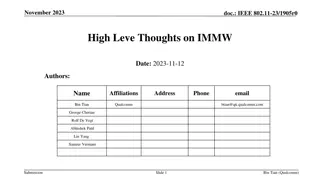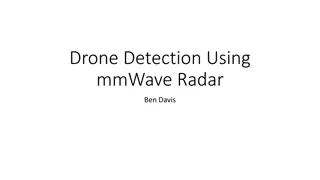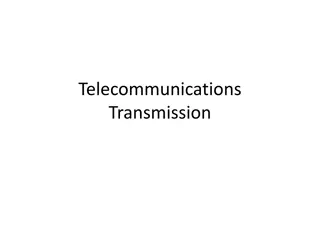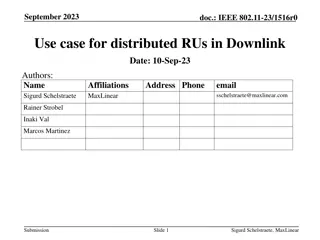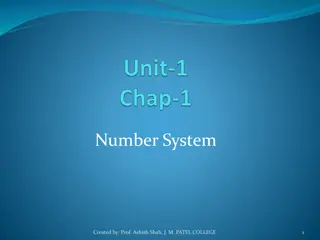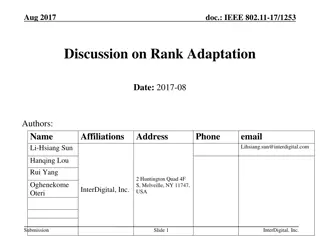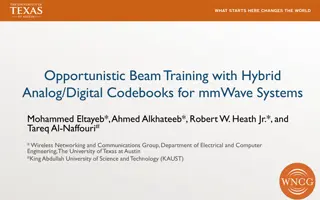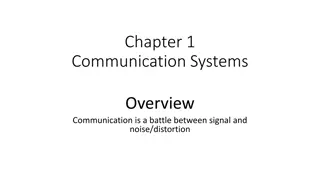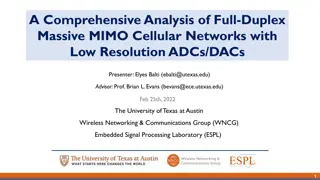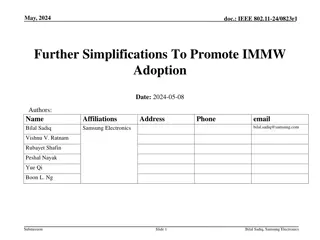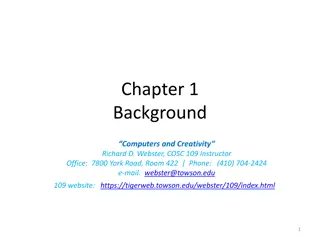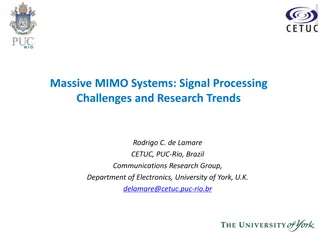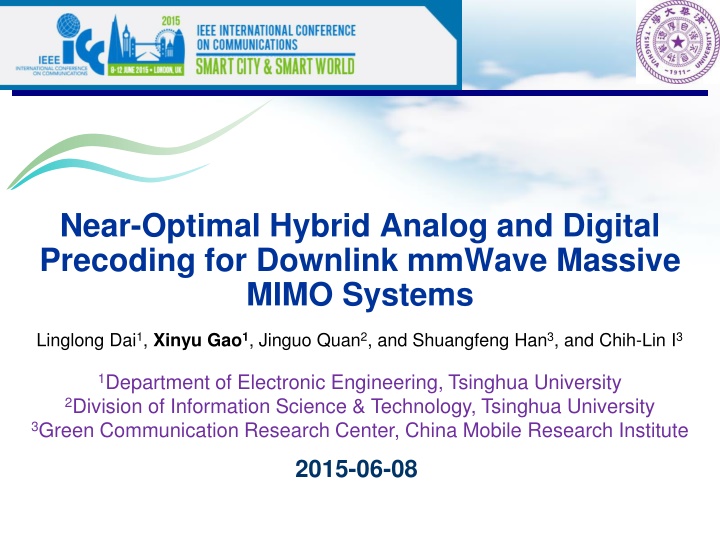
Hybrid Analog and Digital Precoding for mmWave Massive MIMO Systems
Explore the near-optimal hybrid analog and digital precoding techniques for downlink mmWave massive MIMO systems. Learn about the advantages of using short wavelengths and massive MIMO technology, as well as the implementation of hybrid precoding to improve performance while reducing hardware complexity.
Download Presentation

Please find below an Image/Link to download the presentation.
The content on the website is provided AS IS for your information and personal use only. It may not be sold, licensed, or shared on other websites without obtaining consent from the author. If you encounter any issues during the download, it is possible that the publisher has removed the file from their server.
You are allowed to download the files provided on this website for personal or commercial use, subject to the condition that they are used lawfully. All files are the property of their respective owners.
The content on the website is provided AS IS for your information and personal use only. It may not be sold, licensed, or shared on other websites without obtaining consent from the author.
E N D
Presentation Transcript
Near-Optimal Hybrid Analog and Digital Precoding for Downlink mmWave Massive MIMO Systems Linglong Dai1, Xinyu Gao1, Jinguo Quan2, and Shuangfeng Han3, and Chih-Lin I3 1Department of Electronic Engineering, Tsinghua University 2Division of Information Science & Technology, Tsinghua University 3Green Communication Research Center, China Mobile Research Institute 2015-06-08
Contents 1 Technical Background 2 Proposed Solution 3 Complexity Analysis 4 Simulation Results 5 Conclusions 2/17 Near-Optimal Hybrid Analog and Digital Precoding for Downlink mmWave Massive MIMO Systems
3 MmWave massive MIMO Why mmWave? mmWave High frequencies Short wavelength Serious path-loss Spectrum expansion Large antenna array Small cell 1000x capacity increase! Why mmWave + massive MIMO? Short wavelength enables large antenna array in massive MIMO Massive MIMO provides sufficient gains to compensate the serious path-loss by employing precoding 3/17 Near-Optimal Hybrid Analog and Digital Precoding for Downlink mmWave Massive MIMO Systems
4 Precoding for mmWave massive MIMO Traditional precoding Preformed in digital domain One RF chain support one transmit antenna Impractical in hardware for the large antenna array Hybrid precoding Two steps: Digital precoding with small size Analog precoding with large size (realized by phase shifter, PS) One RF chain support several transmit antennas Low hardware complexity without obvious performance loss 4/17 Near-Optimal Hybrid Analog and Digital Precoding for Downlink mmWave Massive MIMO Systems
5 Existing hybrid precoding techniques Two architectures of hybrid precoding Fully-connected Large number of PSs Near-optimal but energy-intensive Sub-connected Smaller number of PSs More energy-efficient RF Chain 1 Antenna Array Baseband Processing NM antennas RF Chain N PA Digital Precoder Analog Precoder (a) Sub-antenna Array 1 Fully-connected Spatially sparse precoding [Ayach 14] Codebook-based hybrid precoding [Roh 14] Baseband Processing RF Chain 1 Sub-antenna Array N Sub-connected Still a challenging problem Baseband Processing RF Chain N PA Digital Precoder Analog Precoder (b) [1] O. El Ayach, et al., Spatially sparse precoding in millimeter wave MIMO systems, IEEE Trans. Wireless Commun., 2014. [2] W. Roh, et al., Millimeter-wave beamforming as an enabling technology for 5G cellular communications: Theoretical feasibility and prototype results, IEEE Commun. Mag., 2014. 5/17 Near-Optimal Hybrid Analog and Digital Precoding for Downlink mmWave Massive MIMO Systems
Contents 1 Technical Background 2 Proposed Solution 3 Complexity Analysis 4 Simulation Results 5 Conclusions 6/17 Near-Optimal Hybrid Analog and Digital Precoding for Downlink mmWave Massive MIMO Systems
Problem formulation System model = + = + y HADs n HPs n , Total achievable rate = + H H I HPP H log . R 2 N 2 N Target Jointly design A and D to maximize achievable rate Three constraints Structure constraint: Amplitude constraint: All elements of have fixed amplitude Power constraint: F N P = = P AD a ia a diag , , diag , , d d 1 1 N N 1/ M 7/17 Near-Optimal Hybrid Analog and Digital Precoding for Downlink mmWave Massive MIMO Systems
SIC-based hybrid precoding Decompose the total achievable rate N R N = T = + 1 H n H p H T Hp log 1 2 1 n n 2 1 n where is the nth column of P, , and n p = + = H n H I HP P H T I 0 n N n N 2 N SIC-based hybrid precoding Total rate sub-rate of sub-antenna array Optimize the rate of each sub-antenna array one by one Sub-antenna array 1 Sub-antenna array 2 Sub-antenna array N = T I 1 T T Set Update matrix Update matrix 0 N N 1 Optimize the sub-capacity Optimize the sub-capacity Optimize the sub-capacity p p p 1 2 N 8/17 Near-Optimal Hybrid Analog and Digital Precoding for Downlink mmWave Massive MIMO Systems
Solution to the sub-rate optimization problem Target Optimize achievable rate of the nth sub-antenna array = + p F = 1 H G H T H where opt n H n p p G p argmaxlog 1 1 1 n n 2 1 n n 2 N n Equivalent problem Consider non-zero elements opt argmaxlog n p where , n G = + H n p p G p 1 2 1 n n 2 N F n = = R 0 I 0 H RG R ( ) ( ) M M n M M N n M 1 1 n 1 Simplify the optimization problem 2 1v = opt n where is the firstright singular vector of p v p G argmin p n 1 n 1 2 F n Find sufficiently close to maximize the achievable sub-rate n p 1v 9/17 Near-Optimal Hybrid Analog and Digital Precoding for Downlink mmWave Massive MIMO Systems
Design of analog and digital precoder Problem Find to minimize n d = p 2 a v p n n ( ) 1 n 2 ( ) ( ) ( ) 2 2 2 = + H H v p v a v a Re 1 Re d 1 1 1 n n n n 2 Solution Analog precoder: Digital precoder: Hybrid precoder: Easy to check all the three constraint conditions are satisfied ( ) v = Re = = angle( ) opt n opt n opt n j a d p 1/ ( 1/ M e ) n ) v 1 = H v a M 11/ v angle( j e M ) 1 ( v 1 11 Summary of our method SVD of to obtain Compute for the nth sub-antenna array Update for the (n+1)th sub-antenna array n G 1v ) G n p 1 opt n ( v = angle( ) j v 1/ M e 1 11 10/17 Near-Optimal Hybrid Analog and Digital Precoding for Downlink mmWave Massive MIMO Systems
Contents 1 Technical Background 2 Proposed Solution 3 Complexity Analysis 4 Simulation Results 5 Conclusions 11/17 Near-Optimal Hybrid Analog and Digital Precoding for Downlink mmWave Massive MIMO Systems
Complexity analysis 1v Computation of Only the firstright singular vector of is required Realized by power iteration algorithm with complexity Acquire the optimal precoder The complexity is only to obtain O G n 1 ( ) 2 O M ( ) ( ) = v angle( j ) opt n p v 1/ M e M 1 11 G Update The calculation can be simplified as + n 1 1 2 1 H is largest singular value of G G v v G 1 , n 1 1 1 1 ( 1 n n 2 2 N N ) Corresponding complexity is 2 O M Total complexity N RF chains ( ) 2 O NM 12/17 Near-Optimal Hybrid Analog and Digital Precoding for Downlink mmWave Massive MIMO Systems
Contents 1 Technical Background 2 Proposed Solution 3 Complexity Analysis 4 Simulation Results 5 Conclusions 13/17 Near-Optimal Hybrid Analog and Digital Precoding for Downlink mmWave Massive MIMO Systems
Simulation results Simulation setup Antennas: (1) (2) RF chains: (1) (2) Channel: Geometric Saleh-Valenzuela model = 128 32 8 = 64 16 N = NM K NM N = K 16 30 25 Optimal unconstrained precoding (fully-connected) Spatially sparse precoding (fully-connected) [6] Optimal unconstrained precoding (sub-connected) Proposed SIC-based precoding (sub-connected) Conventional analog precoding (sub-connected) [21] Optimal unconstrained precoding (full-connected) Spatially sparse precoding (full-connected) [6] Optimal unconstrained precoding (sub-connected) Proposed SIC-based precoding (sub-connected) Conventional analog precoding (sub-connected) [21] 25 20 Achievable rate (bps/Hz) Achievable rate (bps/Hz) 20 15 15 10 10 5 5 0 0 -30 -25 -20 -15 -10 -5 0 -30 -25 -20 -15 SIC-based hybrid precoding is near-optimal -10 -5 0 SNR (dB) SNR (dB) 14/17 Near-Optimal Hybrid Analog and Digital Precoding for Downlink mmWave Massive MIMO Systems
Contents 1 Technical Background 2 Proposed Solution 3 Complexity Analysis 4 Simulation Results 5 Conclusions 15/17 Near-Optimal Hybrid Analog and Digital Precoding for Downlink mmWave Massive MIMO Systems
Conclusions We proposed a SIC-based hybrid precoding with sub-connected architecture Basic ideas: 1) Decompose the total achievable rate into sub-rate 2) Optimize the sub-rate of each sub-antenna array one by one ( ) The computational complexity of our method is only 2 O NM Simulation results verified the near-optimal performance of our method 16/17 Near-Optimal Hybrid Analog and Digital Precoding for Downlink mmWave Massive MIMO Systems
Thanks for your attention ! 17/17 Near-Optimal Hybrid Analog and Digital Precoding for Downlink mmWave Massive MIMO Systems


